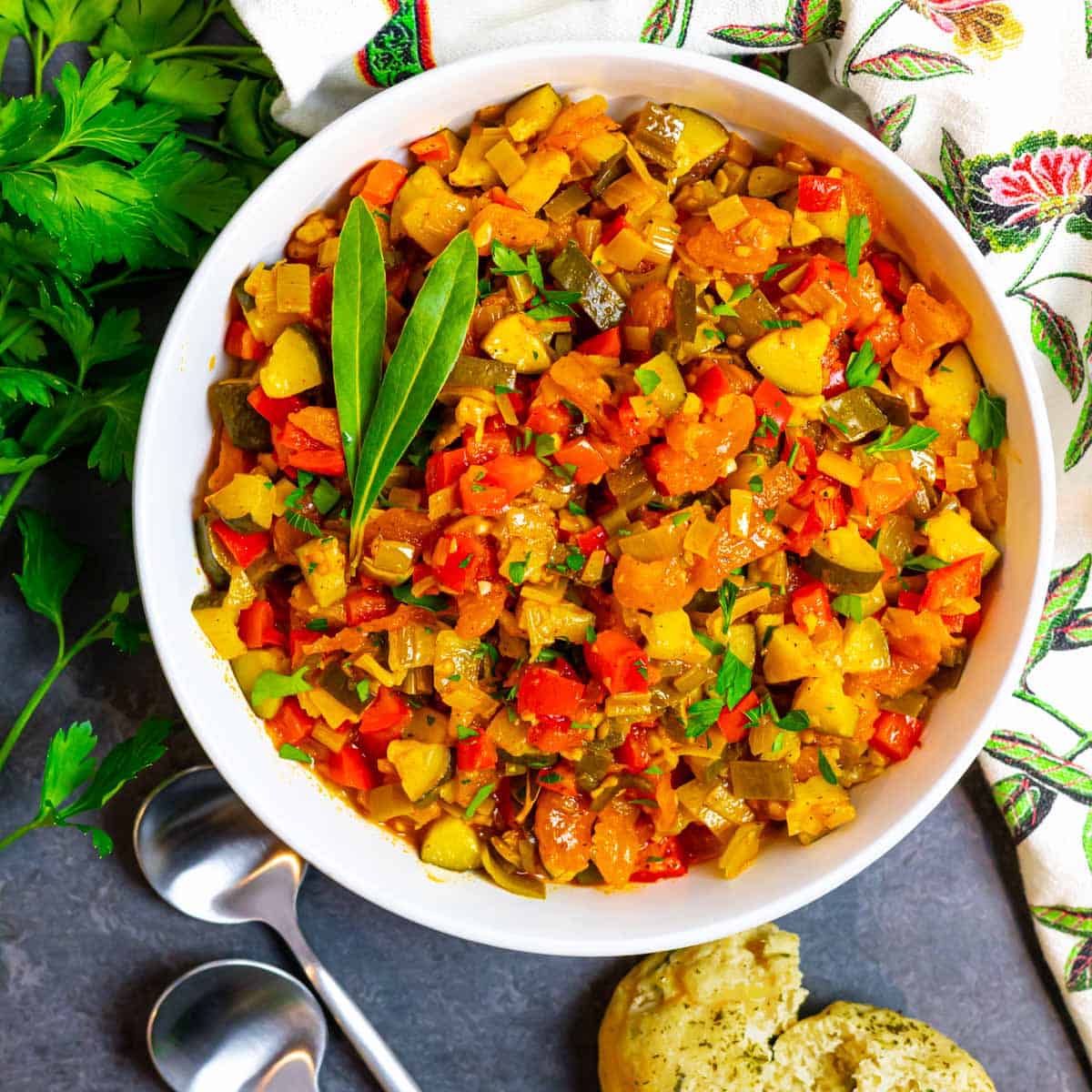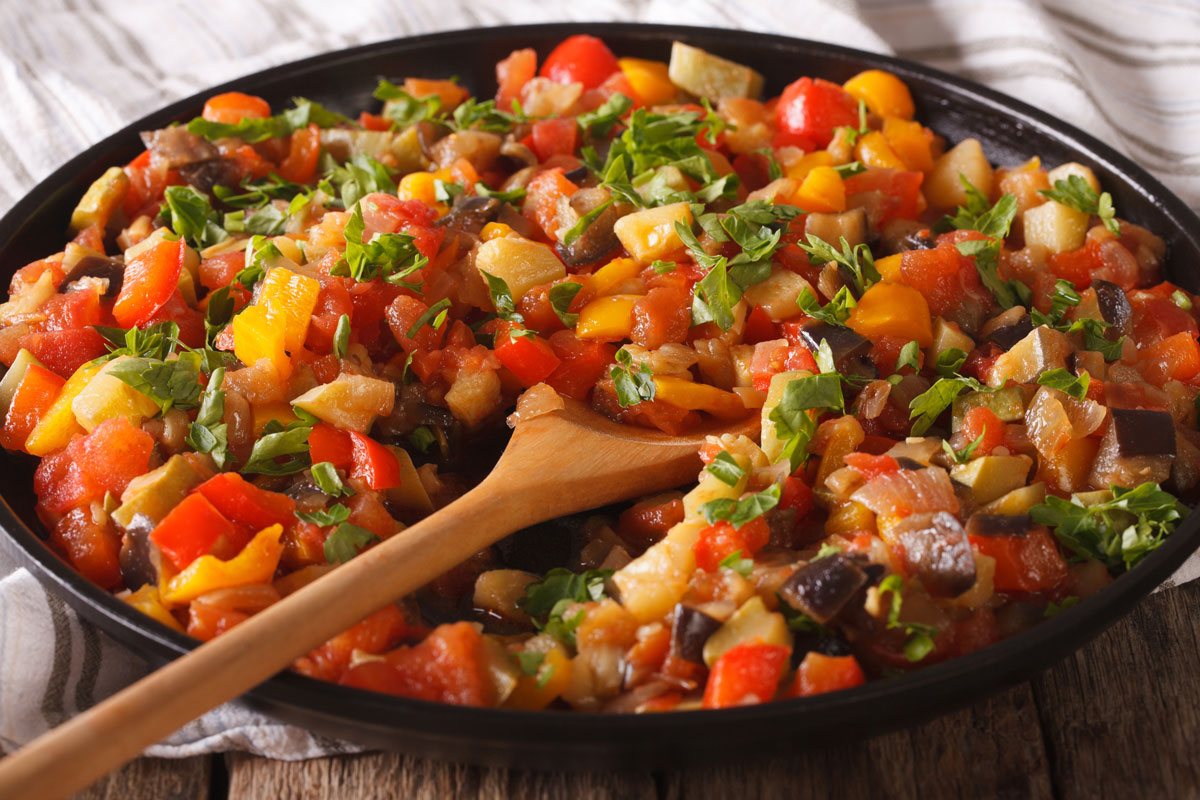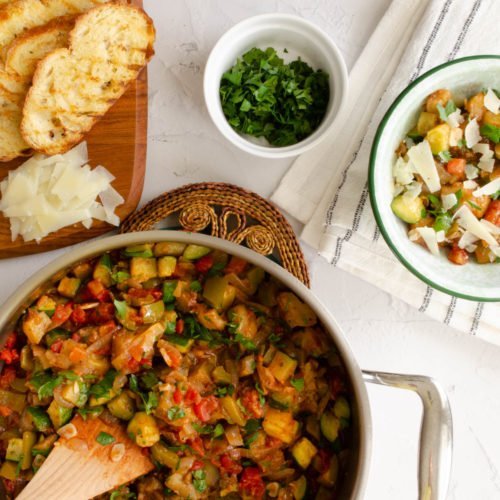During an enchanting journey across Spain, a land renowned for its rich tapestry of flavors and culinary traditions, I was introduced to the captivatingly simple yet profoundly flavorful dish known as Pisto. Amidst my travels, this vegetable medley, often referred to as the Spanish ratatouille, captures the essence of the Mediterranean diet, boasting primary ingredients such as eggs, pack parsley, and sprigs of thyme, which together create a symphony of tastes. The eggs offer a creamy texture that contrasts beautifully with the herby freshness of parsley and the earthy undertone of thyme, all mingling within a rich bed of sautéed vegetables. Fascinated by this harmonious blend of flavors and eager to share this discovery, I embarked on a culinary quest to master Pisto in my own kitchen. My endeavor led me to a beautifully balanced dish that I have had the joy of perfecting. Now, with great pleasure, I wish to pass on this recipe, inviting you to explore the savory depths of Spanish cuisine through the delightful experience of making Pisto at home.

Pisto
Equipment
- 1 large heat-proof soup pot
Ingredients
- 4 large eggs
- 1/2 small pack parsley
- 1 auberge
- 4 large tomatoes
- 2 tablespoon olive oil
- 4 bay leaves
- 2 courgettes
- 2 onions
- 1 heaped teaspoon oregano
- A few thymes sprig
- 5 mixed peppers
- 4 garlic cloves
Instructions
- In a large heat-proof soup pot or a cast-iron pan, heat the oil over medium heat.
- Add the garlic and a pinch of salt, cover, and simmer for fifteen minutes on low heat.
- Cook for the next two minutes after adding the garlic.
- Add the rosemary, basil, garlic cloves, a pinch of black pepper, and a pinch of salt, if desired.
- Crack the eggs gently over the piste, being careful not to shatter the yolks.
- Cook for 5-6 minutes in the sauce over medium heat, until the yolks are done through but still somewhat soft, then garnish with parsley before serving.
Cooking tips about Pisto

- Use Fresh Ingredients: The essence of Pisto lies in the freshness of its vegetables. Choose ripe tomatoes, zucchini, and bell peppers. Fresh herbs such as parsley and thyme not only add to the aroma but also to the authenticity of the dish.
- Cook Vegetables Sequentially: Each vegetable has its own cooking time. Start with those that take longer to cook, like onions and garlic, before adding firmer vegetables such as peppers and finally, integrating softer ones like tomatoes. This ensures every component retains its texture and flavor.
- Olive Oil Is Key: Generous use of good-quality olive oil is crucial in Pisto, as it carries the flavors of the vegetables and herbs throughout the dish. It also adds a distinctive Mediterranean character that is central to its identity.
- Simmer Slowly: Pisto benefits from a slow-cooking process. Allow the mixture to simmer gently, uncovered, so the vegetables can stew in their juices and the flavors can meld together synergistically. This technique also reduces the sauce naturally without making the vegetables too mushy.
- Season Well and Adjust: Salt and freshly ground black pepper are essential, but do adjust according to taste. Incorporate a pinch of sugar if your tomatoes are too acidic. The balance of seasoning can make or break the dish.
- Incorporate Eggs: For a traditional touch, crack a few eggs over the simmering vegetables towards the end of cooking, allowing them to poach in the sauce, or stir them through to create a richer, scrambled texture. This transforms Pisto into a more substantial meal.
- Serve at Any Temperature: Pisto can be served hot, at room temperature, or even cold. Its versatility makes it an excellent accompaniment to a variety of main courses, or it can be enjoyed on its own with crusty bread for sopping up the flavorful sauce.
- Let it Rest: If time allows, letting Pisto sit for a while before serving can enhance its flavors even more, as it gives time for the ingredients to infuse their essences thoroughly.
Serving suggestions about Pisto

- As a Main Course: Serve Pisto as the star of the meal, especially during the warmer months when its lightness and freshness are particularly appealing. You can enhance its substance by topping it with poached or fried eggs, adding a rich, creamy texture that contrasts beautifully with the vegetables.
- With Crusty Bread: Pisto pairs wonderfully with a side of crusty bread, which is perfect for sopping up the flavorful olive oil and vegetable juices. This combination makes for a satisfying and rustic meal that captures the essence of Mediterranean dining.
- Alongside Grilled Meats or Fish: The savory depth of Pisto makes it an excellent accompaniment to grilled meats or fish. The vegetables offer a refreshing counterpoint to the smoky flavors of barbecued chicken, steak, or sea bass, creating a balanced and nutritious plate.
- As a Side Dish: Utilize Pisto as a colorful and flavorful side dish for a larger meal. It’s especially fitting alongside Spanish rice dishes like paella, where it adds a fresh vegetable element to the rich flavors of the rice and seafood or meats.
- Tapas Style: Embrace the Spanish tradition and serve Pisto as part of a tapas spread. Offer it in small bowls alongside other small plates such as Patatas Bravas, jamón serrano, and assorted cheeses. This allows guests to enjoy a variety of flavors and dishes in one sitting.
- Stuffed into Bell Peppers or Zucchini: For a creative presentation, use Pisto as a filling for halved bell peppers or hollowed zucchinis. Bake until the vegetables are tender, and top with a sprinkle of grated cheese for a delightful vegetarian dish.
- Cold as a Salad: Because Pisto can be served at any temperature, consider chilling it and serving it as a salad. Add a splash of vinegar and a drizzle of extra virgin olive oil to brighten the flavors, making for a refreshing summer dish.
- In a Frittata or Omelet: Incorporate Pisto into eggs to make a frittata or omelet, providing a hearty and vegetable-packed breakfast or brunch option. The spices and herbs in the Pisto will infuse the eggs with a wonderful flavor.
Top 5 FAQs about Pisto

- What is Pisto? Pisto is often referred to as the Spanish version of ratatouille. It’s a hearty, flavorful vegetable stew that encapsulates the essence of Mediterranean cuisine. This dish features a blend of sautéed vegetables, where eggs, parsley, and thyme play crucial roles in enhancing its texture and flavor profile, making it not only a celebration of summer’s bounty but also a versatile dish that can be enjoyed in various ways.
- What are the key ingredients in Pisto? The core ingredients of Pisto include tomatoes, zucchini, bell peppers, onions, garlic, olive oil, and herbs like parsley and thyme. Eggs can be added towards the end of cooking for a richer flavor and creamier texture. The simplicity and freshness of the ingredients are paramount to creating an authentic Pisto experience.
- How do you cook Pisto? Cooking Pisto involves a sequential process where vegetables are sautéed according to their cooking times. Start with onions and garlic, followed by firmer vegetables such as peppers, and end with softer ones like tomatoes. A generous amount of olive oil is used to bring out the flavors of the vegetables, and the dish is slowly simmered to allow the flavors to meld. Eggs can be poached in the stew or scrambled through just before serving.
- What makes Pisto unique compared to other vegetable stews? What sets Pisto apart is not only its selection of Mediterranean vegetables but also the method of preparation and the addition of eggs, making it distinctly Spanish. Its slow-cooking process allows for a depth of flavor, where the olive oil plays a crucial role in creating a rich, comforting dish that remains light and healthful. Furthermore, Pisto is versatile, enjoyed hot or cold, making it a unique dish in the realm of vegetable stews.
- How is Pisto served? Pisto can be served in a variety of ways: as a main course topped with poached or fried eggs, as a side dish with crusty bread for dipping, or as part of a tapas spread. It pairs well with grilled meats or fish, offering a fresh counterpoint to richer flavors. Additionally, its versatile nature means it can be enjoyed at any temperature, fitting seamlessly into any meal.

Leave a Reply